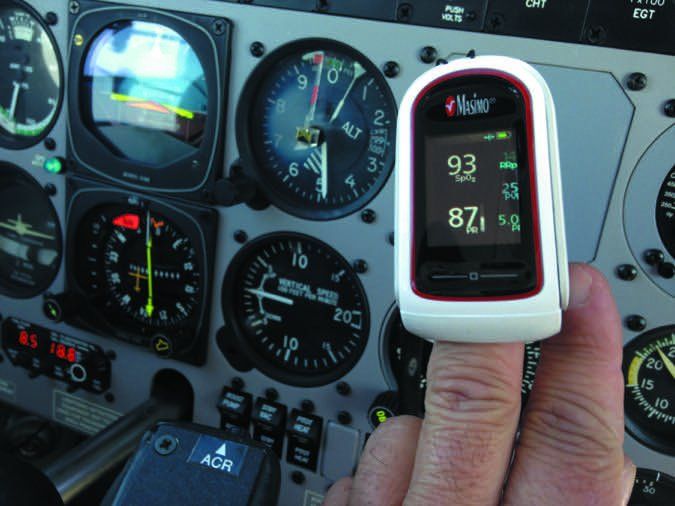Our monthly perusal of NTSB accident data reveals a smattering of accidents caused by hypoxia and many more that could be. We simply lack the data to know for sure, but now that you can buy a pulse oximeter for the price of a good lunch, there’s really no reason you can’t monitor your own blood oxygen saturation on flights where it’s warranted.
As we’re reporting in this article, the range and price of pulse oximeters has expanded during the past decade and with some costing as little as $13, we’re not sure how much cheaper these things can get. It wasn’t always that way, however. As recently as a decade ago, medical-grade oximeters sold for almost $700 or more than twice what the equivalent products sell for today.
The argument for these devices is compelling. If you fly much above 6000 feet, you’ll be less oxygenated than you would be at sea level. But how much less? Traditionally, pilots have been taught to self-diagnose their own hypoxic symptoms, which is fine as far it goes. But an easy-to-use oximeter takes the guesswork out of it and some are cheap enough to stick in the seat pockets of a multi-seat airplane.
For this article we looked at a cross section of what is available, evaluating them at various altitudes from 8650 to 17,500 feet.
Our conclusion? It’s like Alice’s Restaurant—you can get anything you want, at almost any level of complexity, at price points from under $20 to several hundred dollars, and all of them work. Plus, if you are a serious athlete, you can use the oximeter you fly with to enhance your training regimen. It’s a question of deciding what you want.
Internal Workings
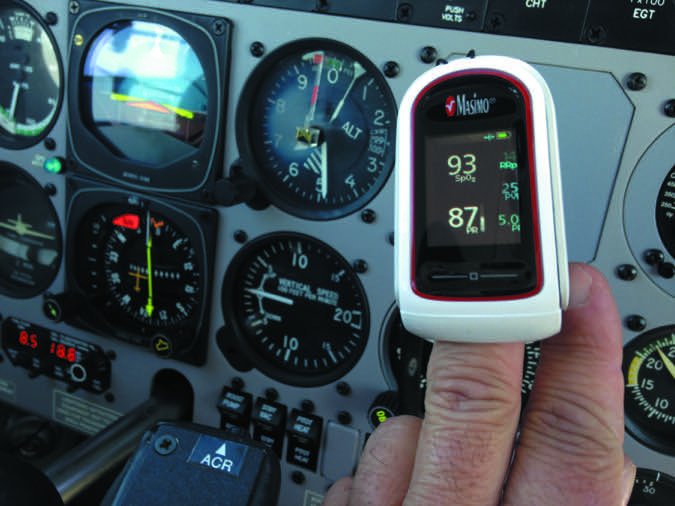
Inside the little box we clip onto a fingertip, a beam of red and infrared light passes through a pulsating capillary bed and a sensor measures the amount of red and infrared light emerging from the tissues. Oxygenated blood absorbs light at 660 nm (red light), whereas deoxygenated blood absorbs light preferentially at 905 nm (infrared).
Each manufacturer uses a proprietary algorithm to collect data from pulsatile arterial blood and ignore local noise from the tissues. The relative absorption of light is processed according to what is known as Beer-Lambert’s law and a qualitative measurement of the user’s percentage of oxygen saturation (SpO2) is derived.
Manufacturers warn that it’s necessary to keep one’s finger stationary during measurement. We found that even in moderate levels of turbulence, all of the pulse oximeters we tried worked just fine. The use of nail polish or wearing of artificial fingernails can degrade the accuracy of, or completely defeat, a pulse oximeter.
While some pilots subscribe to the “what I don’t know won’t hurt me” school of aviation, ignorance of one’s level of blood oxygenation can put a pilot into a world of hurt. Here’s a sample of what’s available on the market.
FaceLake FL400
At $12.95 through Amazon, the FaceLake FL400 Pulse Oximeter came with a lanyard and a protective carrying case. Because this unit has a protruding power switch and we just toss our pulse oximeter into our flight bag, we think some protection against switching the unit on inadvertently is a good thing. Two AAA batteries were included.
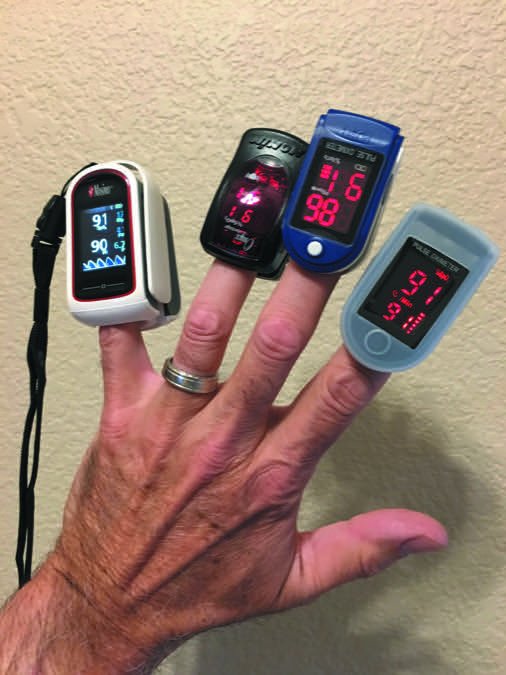
The user manual said that the manual was written in accordance with directives for medical devices, but did not make clear that the unit itself does not meet the standards for medical devices.
The unidirectional LED display is oriented away from the user so to read it, the hand must be palm up and the finger with the oximeter on it pointed at the user. Time for the SpO2 readout to display was 7.5 seconds.
The FL400 SpO2 readout was always within one percentage point of the medically certified unit we used as the baseline for our readings.
Fumbling with the unit outside the airplane, we dropped it on the concrete ramp. We picked it up and checked on it—it worked. It did make us think that we should have attached the lanyard that came with it and we wouldn’t want to drop it more than once or twice.
Acc U Rate
We purchased the Acc U Rate CMS 500DL Fingertip Pulse Oximeter for $18.95 through Amazon. It came with two AAA batteries, a lanyard and silicone protective cover. The surprisingly detailed user manual makes it clear that the product is not for anyone who need SpO2 and pulse rate measurements for a medical condition.
The unidirectional LED display is oriented toward the user with the user’s hand pointed away from the user. In our use, the display began indicating blood oxygen saturation at 12 seconds, with the heart rate showing up slightly sooner. The display could be read reasonably we’ll in bright sunlight in the cockpit. The unit powers off automatically after 16 seconds of nonuse. The only way to get a warranty for the CMS 500DL that we could find was to follow the instructions to register one’s purchase with the manufacturer—which resulted in the issuance of a one-year warranty.
The unit’s readings were within two percentage points of the medical unit we used as a baseline. We bought one of these units three years ago. It lasted two years before giving up the ghost. For an inexpensive unit, it’s our opinion that its accuracy is sufficient for monitoring blood oxygen saturation inflight. While it is not a medical unit, it is better than having nothing at all although it is not as accurate as the cheaper FL400 and doesn’t have a storage case.
Nonin GO2
Nonin is one of the few American makers of pulse oximeters, which pushes up the price a bit. For $89.00 from aeromedix.com, the Nonin GO2 is targeted at active people and pilots who want to know their blood oxygen saturation.
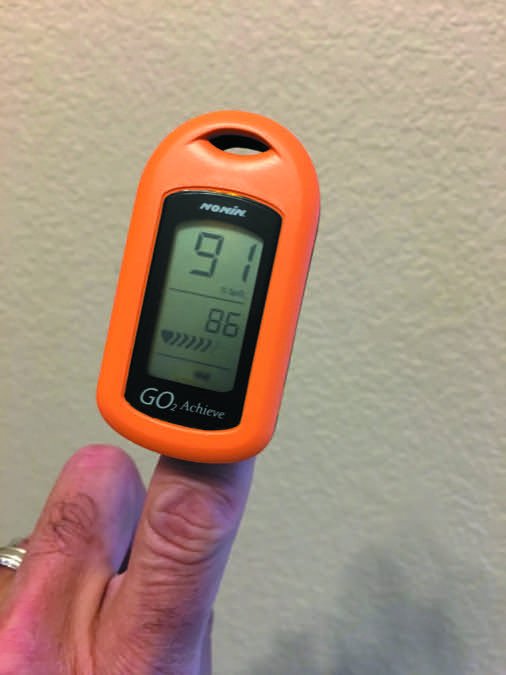
The most streamlined of the units we reviewed, the GO2 comes with a two-year warranty and a lanyard but no carrying case. The unit is more robust in construction than the lower-priced ones we reviewed and, because it turns on automatically when a finger is inserted—no power switch to inadvertently bump—there’s no need for a carrying case. It uses one AAA battery, which was included. Battery installation was the most challenging of all of the units we reviewed.
The unit displayed SpO2 in nine seconds after a finger was inserted. It shut off automatically 10 seconds after the finger was withdrawn. The unidirectional LED display is oriented toward the user when the finger is pointed away. The SpO2 readout matched the medical unit we used for this review. There is a bar measure that shows pulse strength in addition to heart rate.
Nonin 9590 Onyx Vantage
At $225.00 from aeromedix.com, the Nonin 9590 Onyx Vantage is a medical product that is designed for the rough treatment a pilot can give it in service. The Aeromedix website has a video of drop testing the unit, showing that it continued to function accurately after being dropped from waist height 50 times.
Because it is medically certified, it is the unit we used as the baseline for SpO2 levels for this review. It’s a serious unit; unlike the other units reviewed that have brief, paper user manuals, the 9590’s user manual is on a CD even though using it is as easy as its little brother, the Nonin GO2.
The 9590 Onyx Vantage turns on when a finger is inserted, so there is no concern about battery depletion from bumping the power switch in a flight bag. The display showed SpO2 in 7.5 seconds after a finger was inserted. It shut off 10 seconds after the finger was removed. To read the unidirectional display, the finger must be pointed at the user.
Masimo MightySat
Available through the Apple store for $299.00 (down from $399.00 two years ago) the Masimo Mighty Sat MPH-9900 is, in our opinion, the most advanced biometric device available to pilots. Masimo, with Nonin, is the other American big dog in the medical pulse oximeter world. While not certified as a medical device, the MightySat uses technology from the higher-end clinical instruments. It also boasts the ability to obtain accurate readings in undesirable conditions such as chilly fingers in a cold cockpit.
The largest of the oximeters we reviewed, the MightySat also provides the most data on the directionally adjustable display and links the data to your iPhone or iPad for use with Masimo’s Personal Health app. SpO2 data is displayed in 7.5 seconds of the device activating when a finger is inserted. It shuts off within five seconds of the finger being withdrawn.
Powered by two AAA batteries, battery life is advertised at 30 hours. Its SpO2 readings matched the Nonin medical unit we used as a baseline.
Where this unit also shines is in the data presented beyond SpO2 and heart rate—it shows perfusion index (PI), respiratory rate and pleth variability index. The display is clear and easy to read in bright sunlight
PI is the ratio of pulsatile blood flow to the nonpulsatile blood flow—a lower value means lower blood flow. Each person establishes her or his own baseline over time during flying and physical activity.
Pleth variability index is used to evaluate a patient’s fluid status—used for pilots to monitor their hydration. If the value is high, dehydration is a concern as it affects cognition.
Respiration rate (which Masimo calls RRp) in breaths per minute is a tool used by athletes who want to quantify their breathing and by pilots as an indicator of hypoxia—symptoms include rapid breathing and rapid heart rate.
There is a small touchpad below the display used to access the main menu to make changes to the display and Bluetooth functions.
For a pilot who wants real-time and trend monitoring regarding his or her physical condition while flying as we’ll as in physical activity, the MightySat should fit the bill. We do recommend using the provided lanyard and carrying case as we wouldn’t want to drop it.
Oxygenating The Brain
Telling a pilot that a shortage of oxygen to the brain causes hypoxia is akin to telling Noah about the Flood. Pilots learned about that way back in baby pilot school. Plus, they’re tough—they can’t be tripped up by some little molecule.
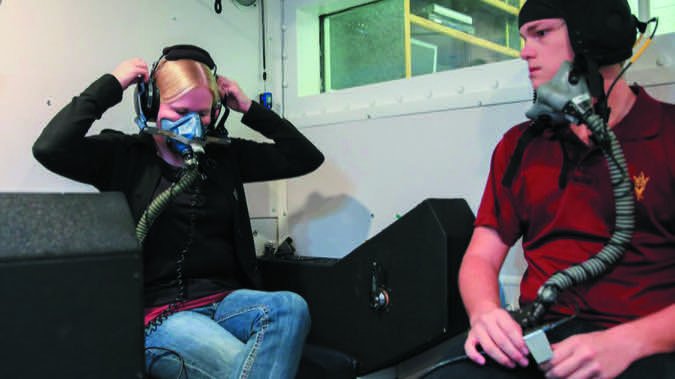
The problem is that hypoxia is one of the most conniving, trickiest and nastiest enemies a healthy human body faces because it simultaneously causes progressively—and eventually profound—cognitive impairment while being utterly charming as it convinces the brain that all is not just well, but absolutely splendid.
That’s the hypobaric (altitude) chamber at Arizona State University in use at right. Unless you’ve been in a hypobaric chamber and/or watched someone in one, at altitude without supplemental oxygen, it’s nearly impossible to understand at a gut level just how hypoxia will cause a pilot to do amazingly foolish things—or do nothing—while being personally convinced he’s doing smart stuff very well. The euphoria caused by hypoxia generally causes the victim to be unable to recognize its onset.
To help understand, we suggest listening to the terrifying exchange between ATC and a hypoxic Learjet crew at: https://tinyurl.com/ycxfm9pc.
FAR 91.211 sets out the rules for the use of supplemental oxygen. Not only were they promulgated before pulse oximetry existed, they ignored what was known in the medical community about hypoxia at the time. The FAA did not publish its justification for its supplemental oxygen regulation that we can find. Our informal research pointed toward the rationale that because supplemental oxygen equipment at the time was heavy and expensive, there was a push to persuade the FAA to allow a pilot to be able to fly across the U.S., including some of the highest mountains, without having to carry oxygen. Accordingly, a pilot can legally climb to 14,000 feet and fly there for 30 minutes without supplemental oxygen, although her or his oxygen saturation will be between 83 and 88 percent. We recognize that the regs have to be one size fits all when it comes to pilots; however, pilots have this disconcerting tendency to be individuals when it comes to their susceptibility to hypoxia. Our ability to oxygenate our blood effectively varies with age, health, sex, time of day, level of fatigue—to name a few of the variables.
For what passes as a “normal” person—in good health and a non-smoker—blood oxygen saturation ranges between 95 and 100 percent at sea level. For reference, without oxygen, the range for that same person at 20,000 feet is 70 to 75 percent. For further reference, Dr. Bruce Chien of Peoria, Illinois, pointed out to us that most hospitals will not accept an “informed consent” from a patient who has a blood oxygen saturation of below 90 percent. You might want to look back at the previous paragraph regarding the saturation range for a pilot at 14,000 feet.
We rely on guidelines published by Dr. Brent Blue (a contributor to Aviation Consumer) regarding supplemental oxygen use to avoid cognitive and physical impairment. They call for use of oxygen when a person’s blood oxygen saturation drops 10 percentage points below what it is at the person’s home altitude. Blue also states that a pilot is likely to suffer less fatigue in flight if supplemental oxygen is started when the percentage is five points below what it is at home.
It is our strong recommendation that following Dr. Blue’s guidelines regarding blood oxygen saturation in making decisions as to altitudes at which to fly and/or the use of supplemental oxygen, rather than relying on FAR 91.211, will substantially reduce the risk of a pilot becoming involved in an accident caused, at least in part, by the effects of hypoxia.
Conclusion
In aviation or even in consumer electronics, we don’t often see a twentyfold price spread between the lowest and highest priced products. But as you can see from the chart here, that’s definitely the case with oximeters. So does spending more get you more? It clearly does, but that’s not the same as needing the product to do more. In basic function, simply measuring SpO2, even the cheapest of these devices gets the job done.
We definitely consider the bottom end products—the FaceLake FL400 and the Acc U Rate—good enough. Even if you replaced them every year or two, at $20, who cares? They aren’t so critical that a failure during flight would endanger the outcome.
If you want more capability and plan to use your oximeter for sports training, the Nonin 9590 and especially the Masimo MightySat are definitely worth considering.
The 9590 is a medical-grade instrument and is robustly built, if that’s a concern. And at even at $225, it’s really not an expensive gadget as airplane stuff goes. Although we performed no durability tests, our view is that is just looks and feels more robust than the cheaper oximeters. We invite comments from readers who may have long-term experience.
The MightySat is the one to buy if you don’t mind the $299 price and you want to pair it with a smartphone or tablet to track your biometric data, especially for fitness training. Serious athletes may use it a lot more for that than for flying.

